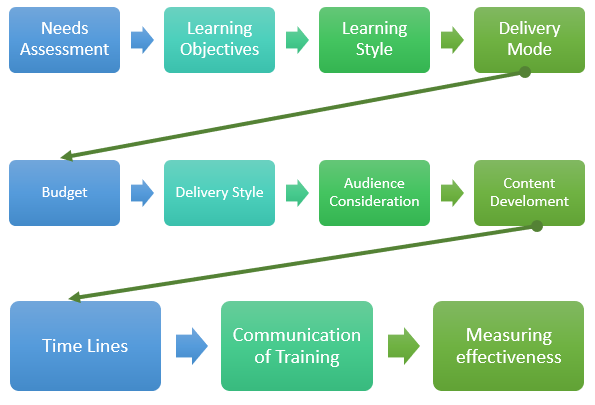Training Program Development
When developing your training plan, there are a number of considerations. Training is something that should be planned and developed in advance.

The considerations for developing a training program are as follows:
- Needs assessment and learning objectives. This part of the framework development asks you to consider what kind of training is needed in your organization. Once you have determined the training needed, you can set learning objectives to measure at the end of the training.
- Consideration of learning styles. Making sure to teach to a variety of learning styles is important to development of training programs.
- Delivery mode. What is the best way to get your message across? Is web-based training more appropriate, or should mentoring be used? Can vestibule training be used for a portion of the training while job shadowing be used for some of the training, too? Most training programs will include a variety of delivery methods.
- How much money do you have to spend on this training?
- Delivery style. Will the training be self-paced or instructor led? What kinds of discussions and interactivity can be developed in conjunction with this training?
- Who will be part of this training? Do you have a mix of roles, such as accounting people and marketing people? What are the job responsibilities of these individuals, and how can you make the training relevant to their individual jobs?
- What needs to be taught? How will you sequence the information?
- How long will it take to develop the training? Is there a deadline for training to be completed?
- How will employees know the training is available to them?
- Measuring effectiveness of training. How will you know if your training worked? What ways will you use to measure this?
Needs Assessment
The first step in developing a training program is to determine what the organization needs in terms of training. There are three levels of training needs assessment: organizational assessment, occupational (task) assessment, and individual assessment:
- Organizational assessment. In this type of needs assessment, we can determine the skills, knowledge, and abilities a company needs to meet its strategic objectives. This type of assessment considers things such as changing demographics and technological trends. Overall, this type of assessment looks at how the organization as a whole can handle its weaknesses while promoting strengths.
- Occupational (task) assessment. This type of assessment looks at the specific tasks, skills knowledge, and abilities required to do jobs within the organization.
- Individual assessment. An individual assessment looks at the performance of an individual employee and determines what training should be accomplished for that individual.
Types of Training and Delivery
| Delivery Method | Type of Training Suggested |
| On-the-job coaching | Technical training |
| Skills training | |
| Managerial training | |
| Safety training | |
| Mentor | Technical training |
| Skills training | |
| Managerial training | |
| Safety training | |
| Brown bag lunch | Quality training |
| Soft skills training | |
| Professional training | |
| Safety training | |
| Web-based | Technical training |
| Quality training | |
| Skills training | |
| Soft skills training | |
| Professional training | |
| Team training | |
| Managerial training | |
| Safety training | |
| Job shadowing | Technical training |
| Quality training | |
| Skills training | |
| Safety training | |
| Job swapping | Technical training |
| Quality training | |
| Skills training | |
| Professional training | |
| Team training | |
| Managerial training | |
| Safety training | |
| Vestibule training | Technical training |
| Quality training | |
| Skills training | |
| Soft skills training | |
| Professional training | |
| Team training | |
| Managerial training | |
| Safety training |
Content Development
The content you want to deliver is perhaps one of the most important parts in training and one of the most time consuming to develop. Development of learning objectives or those things you want your learners to know after the training makes for a more focused training. Think of learning objectives as goals what should someone know after completing this training? Here are some sample learning objectives:
- Be able to define and explain the handling of hazardous materials in the workplace.
- Be able to utilize the team decision process model.
- Understand the definition of sexual harassment and be able to recognize sexual harassment in the workplace.
- Understand and be able to explain the company policies and structure.